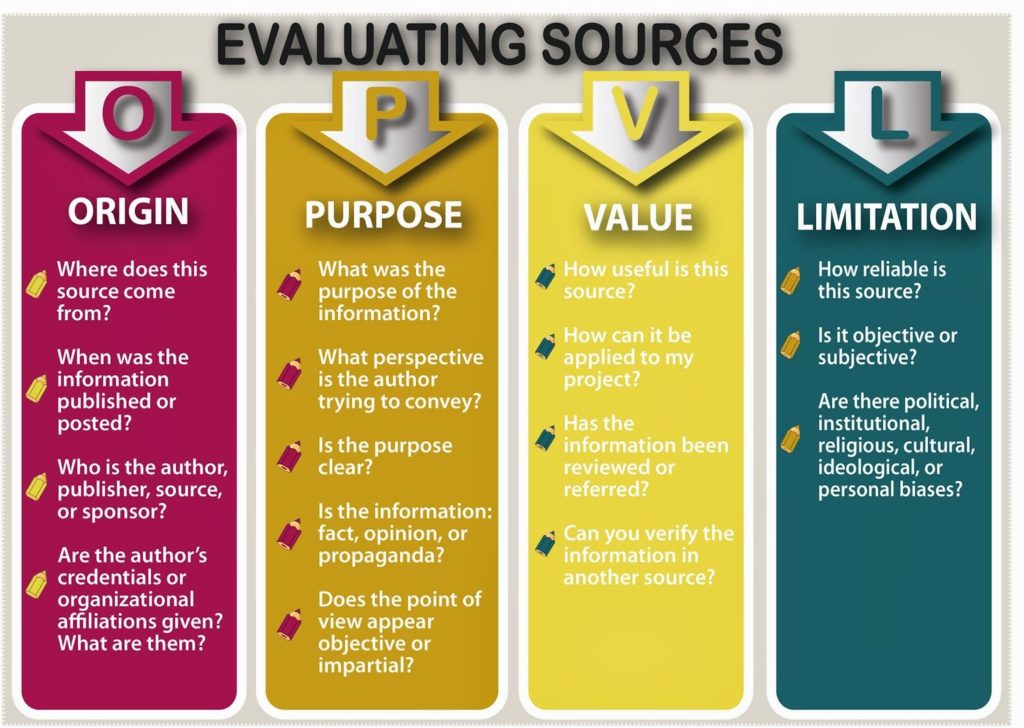What is an “OPVL Analysis”?
OPVL analyses are an important part of research projects. If your child is in the Academy, then chances are at some point you have heard them mention that they have to do an OPVL analysis as part of their project. Maybe you were confused by this and asked yourself, what exactly is an OPVL analysis? Well, look no further, this post will explain to you everything you need to know about OPVL analyses and why it is an important skill to learn – especially in the 21st century.
So, what exactly is an OPVL analysis?
OPVL stands for Origin, Purpose, Value, and Limitations. OPVL is a technique for analyzing sources that is used extensively in the International Baccalaureate curriculum and beyond. It is incredibly helpful for developing students into critical thinkers.
By learning this method of source analysis, students will develop a sense of what sources can be trusted and included in their project and which sources shouldn’t be trusted. This method will help students create more accurate and precise projects as they will have reliable sources that are relevant to their topic. This helps develop students’ critical thinking skills.
When completing an OPVL analysis, students can use the following graphic to help them analyze the source in terms of its Origin, Purpose, Value, and Limitations:
What’s the point of doing OPVL analyses?
When doing research projects, many students will just use whatever information they find on the internet, regardless of its reliability. This can be very problematic, especially in the 21st century, as there exists an abundance of misinformation on the internet. For example, information that has not been fact-checked, not been peer-reviewed, and/or has been written by someone with no qualifications or professional expertise of any kind.
Students must therefore develop critical thinking skills, information literacy skills, and media literacy skills – and learning the OPVL technique is a great first step in this direction.
Practising using the techniques of OPVL analysis allows students to think more critically about the sources they are using. For example, students start to consider the following questions:
- Who wrote this source? For example, what are their qualifications, etc?
- Where did this source come from? For example, from a university? Research organization? Or is it just some random blog post?
- What are some of the strengths/ value of the of the source? For example, in what ways is it helpful to my specific topic?
- What are some of the limitations of the source? For example, what is it missing/ in what ways won’t it help me?
What is an example of an OPVL analysis?
Below is an example of an OPVL analysis that I have taken from this website.
Source being analyzed: Broken Down – YouTube Video (Example)
Origin:
This primary source was created by Jacob Clifford and Adriene Hill two experts who work in the field of Economics. The video was created in 2015 and published on YouTube as educational content for the popular channel Crash Course. Jacob Clifford one of the writers and co-hosts is an entrepreneur and teacher who has a degree from the University of Delaware for economics. Adriene Hill has a bachelor’s degree in political science and economics from Amherst College and a master’s degree for political science from Northwestern University.
Purpose:
The purpose of this video would be to provide educational content for the YouTube community while doing this earning revenue through ads for the company crash course and for co-hosts (Hill and Clifford). The content would also be created to help college, university and high school students learn economics. The authors of this video have no specific perspective rather present both sides
Value:
This source was very useful to me it gave me a basic understanding of how ______ is affecting people around the world and it also provided me with factors and effects I previously think about. The information in this source has been reviewed by some sources and the facts stated corroborate through my reading of other texts of the same information like other ________ and many reputable sources like the world bank.
Limitations:
The source is very reliable and doesn’t seem bias towards anyone, group or class. The source is limited by the fact that it doesn’t provide a lot of specific examples of how globalisation affects certain people rather explains the concepts and theories of globalisation in a general way.
You can read more about OPVL analysis here 🙂




